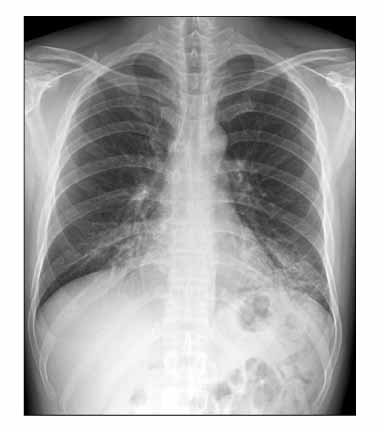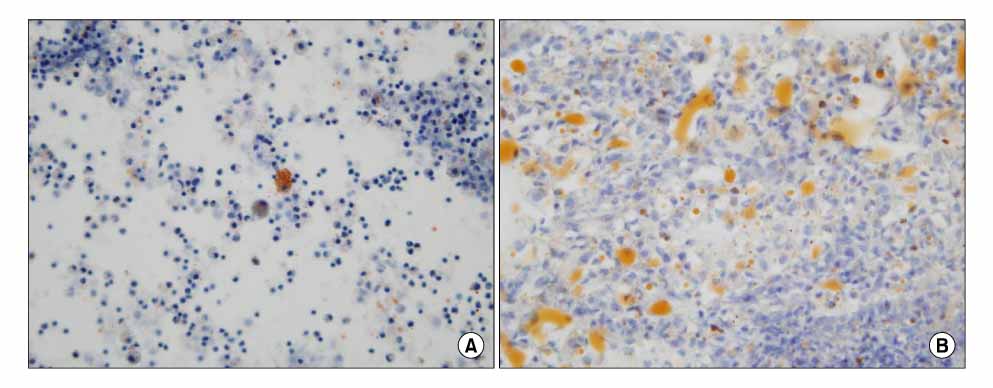Tuberc Respir Dis.
2008 Sep;65(3):239-242.
Bilateral Pulmonary Infiltrate with Milky BAL Fluid
- Affiliations
-
- 1Division of Respiratory and Critical Care Medicine, Department of Internal Medicine, Korea University College of Medicine, Seoul, Korea. yoosh47@unitel.co.kr
Abstract
- Exogenous lipoid pneumonia is an uncommon disease that's caused by aspirating lipid formulations. Squalene, obtained from shark liver oil, is one of the causative agent and this is commonly used by some Koreans as a health promoting medication. We report here on a case of exogenous lipoid pneumonia that developed after ingestion of squalene capsules. The case showed milky BAL fluid and multiple pulmonary consolidations.
Keyword
Figure
Reference
-
1. Laughlen GF. Studies on pneumonia following naso-pharyngeal injections of oil. Am J Pathol. 1925. 1:407–414.2. Asnis DS, Saltzman HP, Melchert A. Shark oil pneumonia. An overlooked entity. Chest. 1993. 103:976–977.3. Camus P, Bonniaud P, Fanton A, Camus C, Baudaun N, Foucher P. Drug-induced and iatrogenic infiltrative lung disease. Clin Chest Med. 2004. 25:479–519. vi.4. Gondouin A, Manzoni P, Ranfaing E, Brun J, Cadranel J, Sadoun D, et al. Exogenous lipid pneumonia: a retrospective multicentre study of 44 cases in France. Eur Respir J. 1996. 9:1463–1469.5. Robinson GV, Kanji H, Davies RJ, Gleeson FV. Selective pulmonary fat aspiration complicating oesophageal achalasia. Thorax. 2004. 59:180.6. de Albuquerque Filho AP. Exogenous lipoid pneumonia: importance of clinical history to the diagnosis. J Bras Pneumol. 2006. 32:596–598.7. Ohwada A, Yoshioka Y, Shimanuki Y, Mitani K, Kumasaka T, Dambara T, et al. Exogenous lipoid pneumonia following ingestion of liquid paraffin. Intern Med. 2002. 41:483–486.8. Park HP, Kwon KY, Choi WI. Lipoid pneumonia in Korea: a case report and review of the literature of Korean cases. Respir Med Extra. 2007. 3:39–43.9. Choi HS, Kwag HJ, Chae SW, Lim SY, Lim SY. Severe exogenous lipoid pneumonia following ingestion of large dose squalene: successful treatment with steroid. Tuberc Respir Dis. 2006. 60:235–238.10. Ioachimescu OC, Kavuru MS. Pulmonary alveolar proteinosis. Chron Respir Dis. 2006. 3:149–159.11. Simmons A, Rouf E, Whittle J. Not your typical pneumonia: a case of exogenous lipoid pneumonia. J Gen Intern Med. 2007. 22:1613–1616.12. Rossi SE, Erasmus JJ, Volpacchio M, Franquet T, Castiglioni T, McAdams HP. "Crazy-paving" pattern at thin-section CT of the lungs: radiologic-pathologic overview. Radiographics. 2003. 23:1509–1519.
- Full Text Links
- Actions
-
Cited
- CITED
-
- Close
- Share
- Similar articles
-
- Angiotensin Converting Enzyme (ACE) in Serum and Bronchoalveolar Lavage (BAL) Fluid in Patients with Active Pulmonary Tuberculosis
- The Clinical Utility of Polymerase Chain Reaction in the Bronchoalveolar Lavage Fluid for the Detection of Mycobacteria
- A Case of Parenchymal Pulmonary Endometriosis Diagnosed by Cytology of Bronchoalveolar Lavage Fluid
- The Expression of Clara Cell Secretory Protein in BAL Fluid of Patients with Idiopathic Interstitial Pneumonia
- Effect of Smoking on Secretory IgA in Bronchoalveolar Lavage Fluid





